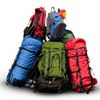How to Plan Your First Backpacking Europe Trip
Shilo Urban
Follow Bakpak Guide's ten tips for planning your first trip to Europe and you will be sure to have a great experience!
1. Get a passport.
For your first passport, you must apply in person, usually at a main post office or other federal building.
2. Get a map of Europe
3. Buy a guidebook and read up on your destination
You will get much more out of your trip if you know a little bit about the art, architecture, and history of Europe. Guidebooks, such as Bakpak’s Europe hostels & travel guide, can also save you time and money, and don’t be afraid to write and/or highlight all over the place- make it yours (Bakpak’s guide includes pages for notes, addresses and a calendar). Talk to friends and other travellers who have been to Europe recently, and remember to take everything with a grain of salt.
4. Assemble your travel companions around map and decide what you want to see
This will be the hardest part of planning your trip. Have everyone make a list with three columns: places you must go, places you would like to go, and places you don’t really care about going. Hash it out; it is better to do so now than after you have landed on the continent.
5. Decide your route and timeline
If you only have three days, then you only have three days, but ideally you want to travel from two weeks to three months. Three months is for the hardcore, and you can do a pretty nice sweep of the continent in a month, if you hustle. The biggest mistake people make when travelling to Europe is to try and do too much in too little time. It may sound crazy, but plan some down time in your trip so you don’t get burned out. Alternate big busy cities with a slow day in the countryside.
6. Decide which cities to fly in and out of and buy a plane ticket
Your best option is probably an open jaw ticket, which lets you fly into one city and out of another. Shop around. Consult websites as well as ticket consolidators. If you are having trouble figuring out your itinerary or the best price, consult an expert travel agent for their experienced advice; most agencies will not charge you a consult fee.
7. Decide your mode of transportation and buy a rail pass or reserve a car
Once you have figured out where and how long you are travelling, you will need the appropriate rail pass; you don’t have to plan every minute of every day but if you can create some sort of itinerary, you will be more likely to buy the correct rail pass and save money. Still confused by rail passes? Consult an expert- most travel agencies give free consults if you are buying a pass.
8. Make a rough itinerary and fine-tune it by adding or cutting cities or sights until it matches your timeline and budget
9. Pack
There are enough packing tips out there to make your head spin, but the best ones are to travel as light as possible and don’t take clothes you normally don’t wear just because someone has listed the items on an essential packing list. If you don’t wear skirts or scarves or khaki cargo pants in your normal life, you are not going to be that happy traipsing around in them overseas.
10. Relax
On your first (or any) trip to Europe, you will get lost. You will make mistakes. You will go the wrong direction on the subway and you will pay too much for something. It is okay; this is why we travel, to learn and grow. Just relax and remember that the happiest travellers are the most flexible travellers.
Featured Articles
Follow Bakpak Guide's ten tips for planning your first trip to Europe and you will be sure to have a great experience!
No matter how manageable your backpack might seem in the comfort of your bedroom at home, I can guarantee that the minute you step off the bus, train or airplane it will feel like you’re lugging around a dead body.
Backpacking in Europe can be pricey. OK, so you shun car hire and hotel rooms in favour of public transport and 40-bed dorms, but...
Europe is not a third-world country, so who needs travel insurance? Not me. I'm a young, free-spirted backpacker. Oh, and I'm covered under my parent's policy.
Some of these are tips you learn from trial and error, some are obvious - we figured we’d try to save you some time.
Free Backpacking Europe Planning & Essentials Guide
Download/More info on the Backpacking Planning and Essentials Guide
Featured Articles
Follow Bakpak Guide's ten tips for planning your first trip to Europe and you will be sure to have a great experience!
No matter how manageable your backpack might seem in the comfort of your bedroom at home, I can guarantee that the minute you step off the bus, train or airplane it will feel like you’re lugging around a dead body.
Backpacking in Europe can be pricey. OK, so you shun car hire and hotel rooms in favour of public transport and 40-bed dorms, but...
Europe is not a third-world country, so who needs travel insurance? Not me. I'm a young, free-spirted backpacker. Oh, and I'm covered under my parent's policy.
Some of these are tips you learn from trial and error, some are obvious - we figured we’d try to save you some time.
Free Backpacking Europe Planning & Essentials Guide
Download/More info on the Backpacking Planning and Essentials Guide






